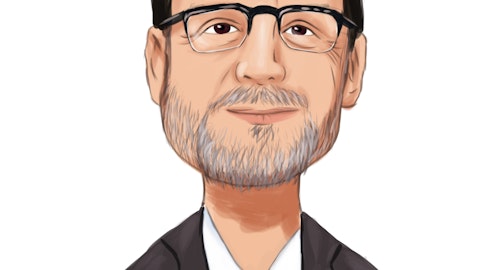Pacific Premier Bancorp, Inc. (NASDAQ:PPBI) Q3 2023 Earnings Call Transcript October 24, 2023
Pacific Premier Bancorp, Inc. misses on earnings expectations. Reported EPS is $0.48 EPS, expectations were $0.56.
Operator: Good day, everyone. And welcome to the Pacific Premier Bancorp Third Quarter 2023 Conference Call. All participants will be in a listen-only mode. [Operator Instructions] After today’s presentation, there will be an opportunity to ask questions. [Operator Instructions] Please note, this event is being recorded. I would now like to turn the conference over to Steve Gardner, Chairman and CEO. Please go ahead, sir.
Steve Gardner: Good morning, everyone. I appreciate you joining us today. As you are all aware, we released our earnings report for the third quarter of 2023 earlier this morning. We have also published an updated investor presentation with additional information and disclosures on our financial results. If you have not done so already, we encourage you to visit our Investor Relations website to download a copy of the presentation and related materials. I note that our earnings release and investor presentation include a Safe Harbor statement relative to the forward-looking comments. I encourage each of you to carefully read that statement. On today’s call, I will walk through some of the notable items related to our third quarter performance.
Ron Nicolas, our CFO, will also review a few of the details surrounding our financial results and then we will open up the call to questions. Over the past 18 months, we have been very strategic and cautionary in terms of accelerating capital accumulation, moderating balance sheet growth and maintaining a commitment to disciplined, prudent liquidity and risk management. As a result, we have been able to maintain a level of flexibility and organizational nimbleness that allows us to act quickly and opportunistically as we navigate a challenging environment, and as I have indicated before, our teams have been highly effective in playing both offense and defense simultaneously. Looking at our results for the quarter, we generated a return on average assets of 0.88% and a return on average tangible common equity of 10.8%.
As we noted in this morning’s earnings release, we had a non-relationship shared national credit placed on non-accrual status that resulted in a $1.7 million interest accrual reversal and a $3.2 million charge-off in the third quarter. As a reminder, in early 2022, at the onset of the rising interest rate environment, we intentionally curtailed loan production in certain business lines through pricing increases and tightening our underwriting standards. Additionally, we were proactive on the liability side of the balance sheet as we opportunistically accessed wholesale funding sources to enhance our liquidity levels at the front end of the current rate cycle. Our available liquidity at the end of the third quarter totaled approximately $11.4 billion, consisting of $1.4 billion in cash and $10 million of additional borrowing capacity.
Pressures on non-maturity deposit balances eased considerably compared to the first two quarters of 2023. As non-interest-bearing deposits ended the quarter at 36.1% of total deposits. Our high quality client relationships and disciplined pricing practices resulted in only a modest increase in the cost of non-maturity deposits to 89 basis points. Notably, we were able to reduce broker deposits by $490 million in the quarter because of our banker’s efforts to reinforce and deepen existing client relationships and attract new clients to the franchise. Even with these successes, we are seeing some customers continue to pursue high yield non-bank alternatives such as direct U.S. treasury purchases and money market mutual funds. Reflecting our emphasis on capital accumulation, our third quarter tangible common equity ratio increased to 9.87% and our third quarter CET1 and total risk-based capital ratios increased 53 basis points and 50 basis points to 14.87%, and 17.74%, respectively.
On a year-over-year basis, our total risk-based capital and CET1 ratios each increased more than 250 basis points and rank among the strongest capital levels in the industry. Contraction in our overall loan portfolio balances slowed considerably in the third quarter and we believe we could be approaching an inflection point in the coming quarters. Prepayment activity slowed in the quarter, although we continue to see some businesses and real estate investor clients utilizing excess cash reserves to reduce outstanding debt. We will continue to take a thoughtful approach towards loan origination activity, maintaining our focus on bringing in high quality banking relationships into the organization that meet our risk-adjusted return requirements.
Given where we are in the credit cycle, there’s a significant amount of uncertainty around commercial real estate performance. With that in mind, I’d like to spend a minute discussing our credit risk management philosophy, which has served us well throughout a variety of cycles. We remain committed to our longstanding approach to disciplined underwriting standards, which historically has resulted in superior long-term performance across our loan portfolios. We spend credit to businesses and real estate investors that have a well-established operating history and a documented track record of positive cash flow. We underwrite loans based on actual rather than projected borrower cash flows. We generally require personal guarantees on the vast majority of our loans from guarantors who typically have ample sources of liquidity and other available assets.
We have a granular customer base, consisting mainly of small and middle market businesses, along with seasoned real estate operators, which is reflected in our relatively low average loan size. Our loan to values are conservative, while our debt coverage ratios are strong. Our loan portfolio is structured with a balance of hybrid adjustable and fixed rate loans with de minimis loan maturities over the next 10 quarters to 12 quarters. Our portfolio managers are proactive in monitoring for any change in borrower financial performance which enables them to quickly detect trends that could impact our portfolio. Additionally, CRE concentrations are stress tested semiannually and continue to move lower as we accumulate capital and moderate new origination activity.
Overall, our loan portfolio is well managed across the organization. We expect it to perform well throughout the cycle. Our third quarter asset quality results were solid, as total delinquency decreased to 0.08% of total loans and non-performing assets were just 0.13% of total assets. As I mentioned earlier, through the shared national credit review process, we had a non-relationship participation placed on non-accrual status. The shared national credit portfolio, which is a legacy Opus line of business that was discontinued totals 22 loans for $201 million in outstanding balances or 1.5% of total loans at September 30th. With that, I will turn the call over to Ron to provide a few more details on our third quarter financial results.

An employee counting notes in the back office of a bank.
Ron Nicolas: Thanks, Steve, and good morning. For comparison purposes, my comments today are on a linked-quarter basis unless otherwise noted. Let’s start with the quarter’s results. Third quarter net income totaled $46 million or $0.48 per share and our return on average assets and average tangible common equity were 0.88% and 10.08%, respectively. Total revenue was $168.1 million and our non-interest expense came in at $102.2 million resulting in an efficiency ratio of 59% and pre-provision net revenue as a percentage of average assets of 1.27% for the quarter. All of our regulatory capital ratios increased significantly and our TCE ratio grew to 9.87%. Taking a closer look at the income statement. Net interest income decreased to $149.5 million, primarily as a result of higher cost of funds, as well as a smaller balance sheet reflecting our strategy to moderate new loan origination activity in the current operating environment.
On the funding side, both our deposit mix, as well as our higher cost of funds impacted the net interest margin, which was 3.12% in the third quarter. Our non-maturity deposit costs were well controlled at 0.89% and our total deposit costs were 1.50%. On a cumulative total deposit beta of 28% reflects our disciplined pricing actions throughout this rate cycle. Earning asset yields were flat compared to the second quarter, which included the impact of 4 basis points due to the reversal of nine months of accrued interest on the shared national credit that Steve referenced earlier. Looking ahead, we would anticipate some net interest margin pressure from higher funding costs in the higher for longer interest rate environment. That being said, we intend to mitigate some of those pressures through continued balance sheet optimization by reducing cash on hand and higher cost wholesale funding.
We began to execute this strategy during the quarter as we reduced our level of brokered deposits by $490 million compared to June 30th. Also, in early October, we paid down $200 million of FHLB advances with a cost of 4.84% that were set to mature in May of 2024. Non-interest income of $18.6 million decreased $2 million from the prior quarter, driven by a $1.8 million of lower operating income. Both trust custodial account fees and escrow and exchange fees generated similar levels of non-interest income compared to the prior quarter. For the fourth quarter of 2023 we expect our total non-interest income to be in the range of $18 million to $19 million. Non-interest expense increased slightly to $102.2 million mostly due to an expected $1.6 million increase in deposit expense related to higher earnings credit rates.
Compensation and benefit expense increased $644,000 to $54.1 million. From a staffing perspective, we ended the quarter with a headcount of 1,355, compared to 1,383 as of June 30th, as our staffing levels continue to fall, commensurate with our smaller balance sheet. We remain focused on tightly managing our operating expenses and we expect fourth quarter expenses to remain relatively flat in the range of $102 million to $103 million. Provision for credit losses of $3.9 million increased slightly from the prior quarter as our ACL coverage ratio increased 1 basis point to 1.42%, commensurate with the relative size of our loan portfolio and our economic outlook. Turning now to the balance sheet. We finished the quarter at $20.3 billion in total assets as we saw less loan portfolio contraction compared to the prior quarter due to slower prepayment activity.
Total loans held for investment declined $346 million driven by prepayments, sales and maturities of $371 million, partially offset by new loan commitments of $68 million, reflecting our disciplined underwriting and pricing standards. Total deposits ended the quarter at $16 billion, which represented a linked quarter decrease of $532 million, primarily due to a $490 million decrease in higher cost brokered CDs. We continue to exercise deposit pricing discipline, which has somewhat pressured non-maturity deposit balances during 2023 and led some customers to redeploy their cash reserves into higher yielding alternatives. The securities portfolio decreased $97 million to $3.7 billion and the average yield on our investment portfolio increased 6 basis points to 2.70%.
Not surprising, given the late quarter surge in interest rates, our pretax AOCI on the AFS portfolio increased to $296.7 million, but still remain below our December 31, 2022 fair value mark. We anticipate approximately $100 million in cash flow from the amortization and maturities of our investment portfolio over the remainder of the year and reinvestment will be dependent upon deposit flows, funding mix and liquidity considerations. The combination of consistent profitability and a smaller balance sheet bolstered our risk-based capital ratios this quarter with all ratios increasing significantly from June 30, 2023. In addition, our tangible common equity ratio increased 28 basis points to 9.87% and our tangible book value per share increased $19.89.
And lastly, from an asset quality standpoint, our asset quality remains solid across multiple measures. Non-performing assets increased 5 basis points to 0.13%, a slight increase from the prior quarter. Additionally, total delinquency decreased to just 8 basis points and our total classified loans ended the quarter at 1.12%. Our allowance for credit losses remained a healthy $188.1 million and our coverage ratio increased to 1.42%. Our total loss absorption, which includes the fair value discount on loans acquired through acquisition finished the quarter at 1.76%. With that, I will turn the call back to Steve.
Steve Gardner: Great. Thanks, Ron. I will wrap up with a few comments about our outlook. As we head into year-end in 2024, we will continue to take a thoughtful approach with respect to liquidity, balance sheet growth, risk management and building capital. We expect the environment to remain challenged for the foreseeable future as businesses and real estate investors adjust to the evolving economic and interest rate environment. At this point, we are prepared for the higher for longer interest rate scenario and the corresponding ramifications it may have on the broader industry. Our organization is well positioned to opportunistically diversify our business in a disciplined, prudent fashion through organic and strategic growth as a result of the disruptions taking place in our markets.
In addition, we anticipate that the challenges our industry faces may intensify which in turn could create additional opportunities for us. In conclusion, we are entering the fourth quarter from a position of strength and our teams remain keenly focused on executing our business strategy to deliver long-term value for our shareholders. That concludes our prepared remarks and we would be happy to answer any questions. Operator, please open up the call for questions.
See also George Soros Net Worth and Top 10 Holdings Heading into 2024 and 12 Most Undervalued Travel Stocks To Buy According To Hedge Funds.
Q&A Session
Follow Pacific Premier Bancorp Inc (NASDAQ:PPBI)
Follow Pacific Premier Bancorp Inc (NASDAQ:PPBI)
Operator: Thank you. [Operator Instructions] Our first question comes from David Feaster with Raymond James. Please go ahead.
David Feaster: Hi. Good morning, everybody.
Steve Gardner: Hi, David.
David Feaster: Maybe just kind of following up on your commentary both you, Steve and Ron. It seems like this higher for longer environment is probably the new normal. I am just curious, you touched on it a bit, I was hoping that we could dig into the balance sheet and margin trajectory in a higher for longer environment. You guys have been very active managing the balance sheet, but just how do you think about the margin trajectory in light of the moves that you have made, the proactive liquidity management reduction in some of the wholesale funding. And then maybe just more broadly, Steve, to your point, just how do you think about the broader economy and the bank’s performance in a higher for longer environment?
Steve Gardner: Sure. Well, Ron, why don’t — I will let Ron go ahead and David address the margin and our outlook and then I am certainly happy to give you my perspective on the outlook for the economy.
Ron Nicolas: Sure. Thanks, Steven. And David, so as we have indicated, we are going to be managing as much as we are able to, of course, depending on deposit flows, deposit mix that cost of deposits. That’s our primary focus. We are still originating albeit at lower levels, but the loans that we are bringing on the books, of course, are coming in at higher yields. So that should also add to the net interest margin. And as we move forward, I do anticipate, although the denominator effect of the deposit beta is going to be — because that’s decelerating, it’s going to give rise to a higher beta on a quarterly basis. I do anticipate deposit pricing to start to decelerate as we move into 2024 and that. So we do look for some level of stabilization.
We are still getting a little bit of repricing as — if there is another move on the asset side. So that should also help. So there’s a lot of moving parts to this. We will see how it plays itself out. But we are very, very focused on that deposit cost and managing the balance sheet tightly in that respect.
Steve Gardner: I think I’d certainly add, Ron, that as we highlighted, we have been certainly laser focused on reducing higher cost wholesale funding, which we took down starting in early 2022 and we expect that to benefit us as we move through the end of this year and into next year. As far as the economic outlook, it’s — so it’s certainly an unusual environment where we have from all indications, preliminary estimates on GDP as very strong, 5% handle in the third quarter. Employment continues to be strong, low unemployment rate, 3.8%. But at the same time, we have some of these dynamics going on from the commercial real estate markets and as investors and businesses adjust to this rapid rise in interest rates, I think, it remains uncertain how all of this plays out and that’s certainly informing our approach to managing the balance sheet and capital levels liquidity as I highlighted to ensure that we are in a position to take advantage of what we believe are going to be opportunities here as we move through 2024 to further grow and expand our franchise.
David Feaster: Okay. And maybe to that point, you talked about in your prepared remarks, it sounds like we are closer to an inflection point on the loan portfolio. I am just curious maybe if you could elaborate there. You talked about proactively slowing growth some time ago through pricing and just your disappoint. I am just curious how is demand trending from your perspective, what’s the pipeline look like and the composition of that? Where are you just — where are you seeing good risk-adjusted returns with origination rates over 8% and how do you think about loan growth?



